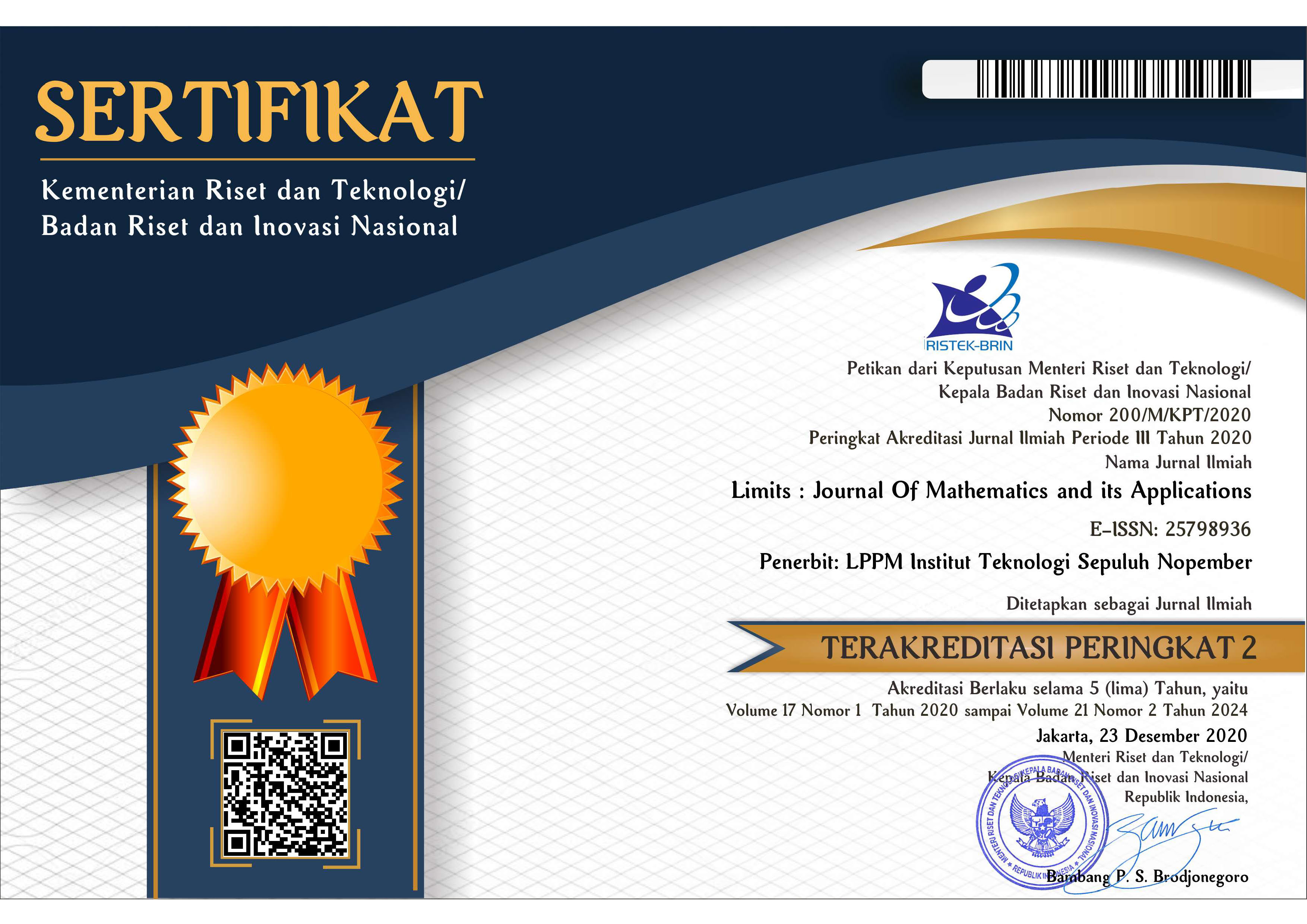Komparasi Model Pertambahan Tinggi Badan Balita Stunting Dengan Metode Regresi Kuantil dan Regresi Kuantil Bayesian
Abstract
Penelitian ini bertujuan untuk mengkonstruksi model pertambahan tinggi badan balita stunting di Kabupaten Solok dengan menggunakan metode regresi kuantil dan metode regresi kuantil Bayesian. Metode regresi kuantil merupakan metode pendugaan parameter yang dilakukan dengan membagi data menjadi dua bagian yang tidak harus simetri ketika dicurigai terdapat perbedaan nilai estimator pada kuantil-kuantil tertentu. Metode regresi kuantil Bayesian merupakan metode pendugaan parameter yang menggabungkan konsep analisis kuantil ke dalam pendekatan Bayesian. Pada pendekatan Bayesian, digunakan distribusi Asymmetric Laplace Distribution (ALD) dalam pembentukan fungsi likelihood sebagai dasar dari pembentukan distribusi posterior yang digunakan dalam proses pendugaan parameter. Data penelitian yang digunakan adalah data 950 balita stunting di Kabupaten Solok pada bulan Agustus 2021 dan bulan Februari 2022. Pada penelitian ini diperoleh bahwa metode regresi kuantil Bayesian menghasilkan model dugaan yang lebih baik daripada metode regresi kuantil. Kriteria kebaikan model adalah berdasarkan lebar selang kepercayaan 95% terpendek dan nilai terbesar. Faktor-faktor yang signifikan dalam mempengaruhi pertambahan tinggi badan balita stunting di Kabupaten Solok adalah jenis kelamin, berat badan lahir, ASI eksklusif, dan imunisasi.
Keywords
Full Text:
PDFReferences
M. Ekholuenetale, A. Barrow, C. E. Ekholuenetale, and G. Tudeme, “Impact of stunting on early childhood cognitive development in Benin: evidence from Demographic and Health Survey,” Egypt Pediatric Association Gaz, vol. 68, no. 1, p. 31, Dec. 2020, doi: 10.1186/s43054-020-00043-x.
M. Rosyidah, Y. L. R. Dewi, and I. Qadrijati, “Effects of Stunting on Child Development: A Meta-Analysis”.
L. Tanzil and H. Hafriani, “FAKTOR-FAKTOR YANG MEMPENGARUHI TERJADINYA STUNTING PADA BALITA USIA 24-59 BULAN,” JurKebMal, vol. 7, no. 1, pp. 25–31, Jan. 2021, doi: 10.33024/jkm.v7i1.3390.
Y. Yuwanti, F. M. Mulyaningrum, and M. M. Susanti, “FAKTOR – FAKTOR YANG MEMPENGARUHI STUNTING PADA BALITA DI KABUPATEN GROBOGAN,” j. keperawatan. kesehat. masy. cendekia. utama., vol. 10, no. 1, pp. 74–84, Mar. 2021, doi: 10.31596/jcu.v10i1.704.
N. Desviona and F. Yanuar, “Simulation Study of Autocorrelated Error Using Bayesian Quantile Regression,” sci. technol. indones., vol. 5, no. 3, pp. 70–74, Jul. 2020, doi: 10.26554/sti.2020.5.3.70-74.
F. Yanuar, H. Yozza, and A. Zetra, “Bayesian Quantile Regression Methods in Handling Non-normal and Heterogeneous Error Term,” Asian J. of Scientific Research, vol. 12, no. 3, pp. 346–351, Jun. 2019, doi: 10.3923/ajsr.2019.346.351.
F. Yanuar, “The Simulation Study to Test the Performance of Quantile Regression Method With Heteroscedastic Error Variance,” CAUCHY, vol. 5, no. 1, p. 36, Nov. 2017, doi: 10.18860/ca.v5i1.4209.
F. Yanuar, A. S. Deva, A. Zetra, and M. Maiyastri, “Length of hospital stay model of COVID-19 patients with quantile Bayesian with penalty LASSO,” Commun. Math. Biol. Neurosci., vol. 23, no. 1–18, 2023, doi: 10.28919/cmbn/7881.
R. Alhamzawi, K. Yu, and D. F. Benoit, “Bayesian adaptive Lasso quantile regression,” Statistical Modelling, vol. 12, no. 3, pp. 279–297, 2012, doi: 10.1177/1471082X1101200304.
R. Alhamzawi and K. Yu, “Variable selection in quantile regression via Gibbs sampling,” Journal of Applied Statistics, vol. 39, no. 4, pp. 799–813, 2012, doi: 10.1080/02664763.2011.620082.
K. Yu and R. A. Moyeed, “Bayesian quantile regression,” Statistics & Probability Letters, vol. 54, pp. 437–447, 2001.
H. Kozumi and G. Kobayashi, “Gibbs sampling methods for Bayesian quantile regression,” Journal of Statistical Computation and Simulation, vol. 81, no. 11, pp. 1565–1578, Nov. 2011, doi: 10.1080/00949655.2010.496117.
D. F. Benoit and D. Van den Poel, “Binary quantile regression: a Bayesian approach based on the asymmetric Laplace distribution,” J. Appl. Econ., vol. 27, no. 7, pp. 1174–1188, Nov. 2012, doi: 10.1002/jae.1216.
Y. Feng, Y. Chen, and X. He, “Bayesian quantile regression with approximate likelihood,” Bernoulli, vol. 21, no. 2, pp. 832–850, May 2015, doi: 10.3150/13-BEJ589.
Y. Yang, H. J. Wang, and X. He, “Posterior Inference in Bayesian Quantile Regression with Asymmetric Laplace Likelihood: Bayesian Quantile Regression,” International Statistical Review, vol. 84, no. 3, pp. 327–344, 2015, doi: 10.1111/insr.12114.
E. J. Nam, E. K. Lee, and M.-S. Oh, “Bayesian quantile regression analysis of Korean Jeonse deposit,” CSAM, vol. 25, no. 5, pp. 489–499, 2018, doi: 10.29220/CSAM.2018.25.5.489.
M.-S. Oh, J. Choi, and E. S. Park, “Bayesian variable selection in quantile regression using the Savage–Dickey density ratio,” Journal of the Korean Statistical Society, vol. 45, no. 3, pp. 466–476, 2016, doi: 10.1016/j.jkss.2016.01.006.
F. Yanuar, H. Yozza, F. Firdawati, I. Rahmi, and A. Zetra, “Applying bootstrap quantile regression for the construction of a low birth weight model,” Makara Journal of Health Research, vol. 23, no. 2, pp. 90–95, Aug. 2019, doi: 10.7454/msk.v23i2.9886.
R. Alhamzawi, K. Yu, and H. Mallick, “Quantile Regression and Beyond in Statistical Analysis of Data,” Journal of Probability and Statistics, vol. 2019, pp. 1–1, Jul. 2019, doi: 10.1155/2019/2635306.
R. Alhamzawi, “Bayesian Elastic Net Tobit Quantile Regression,” Communications in Statistics - Simulation and Computation, vol. 45, no. 7, pp. 2409–2427, Aug. 2016, doi: 10.1080/03610918.2014.904341.
R. Alhamzawi and K. Yu, “Bayesian Lasso-mixed quantile regression,” Journal of Statistical Computation and Simulation, vol. 84, no. 4, pp. 868–880, Apr. 2014, doi: 10.1080/00949655.2012.731689.
R. Alhamzawi and K. Yu, “Bayesian Tobit quantile regression using g -prior distribution with ridge parameter,” Journal of Statistical Computation and Simulation, vol. 85, no. 14, pp. 2903–2918, Sep. 2015, doi: 10.1080/00949655.2014.945449.
DOI: http://dx.doi.org/10.12962%2Flimits.v20i2.9581
Refbacks
- There are currently no refbacks.
Jumlah Kunjungan:

Limits: Journal Mathematics and its Aplications by Pusat Publikasi Ilmiah LPPM Institut Teknologi Sepuluh Nopember is licensed under a Creative Commons Attribution-ShareAlike 4.0 International License.
Based on a work at https://iptek.its.ac.id/index.php/limits.






